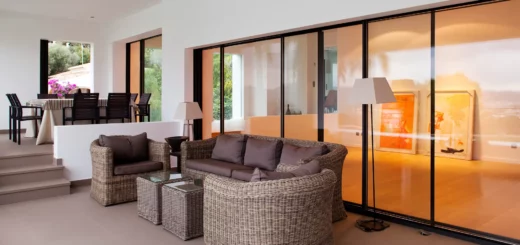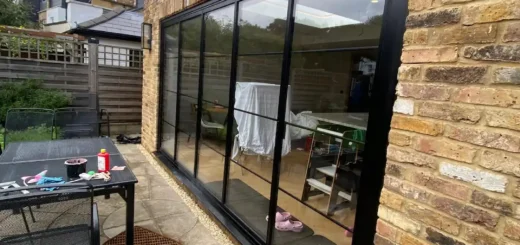Choosing Glass Living Room Doors – Design Guide
Table of Contents
What Makes Glass Living Room Doors Special?
Glass living room doors bring light and views into your main living space while creating a striking focal point.
Natural Light Done Right
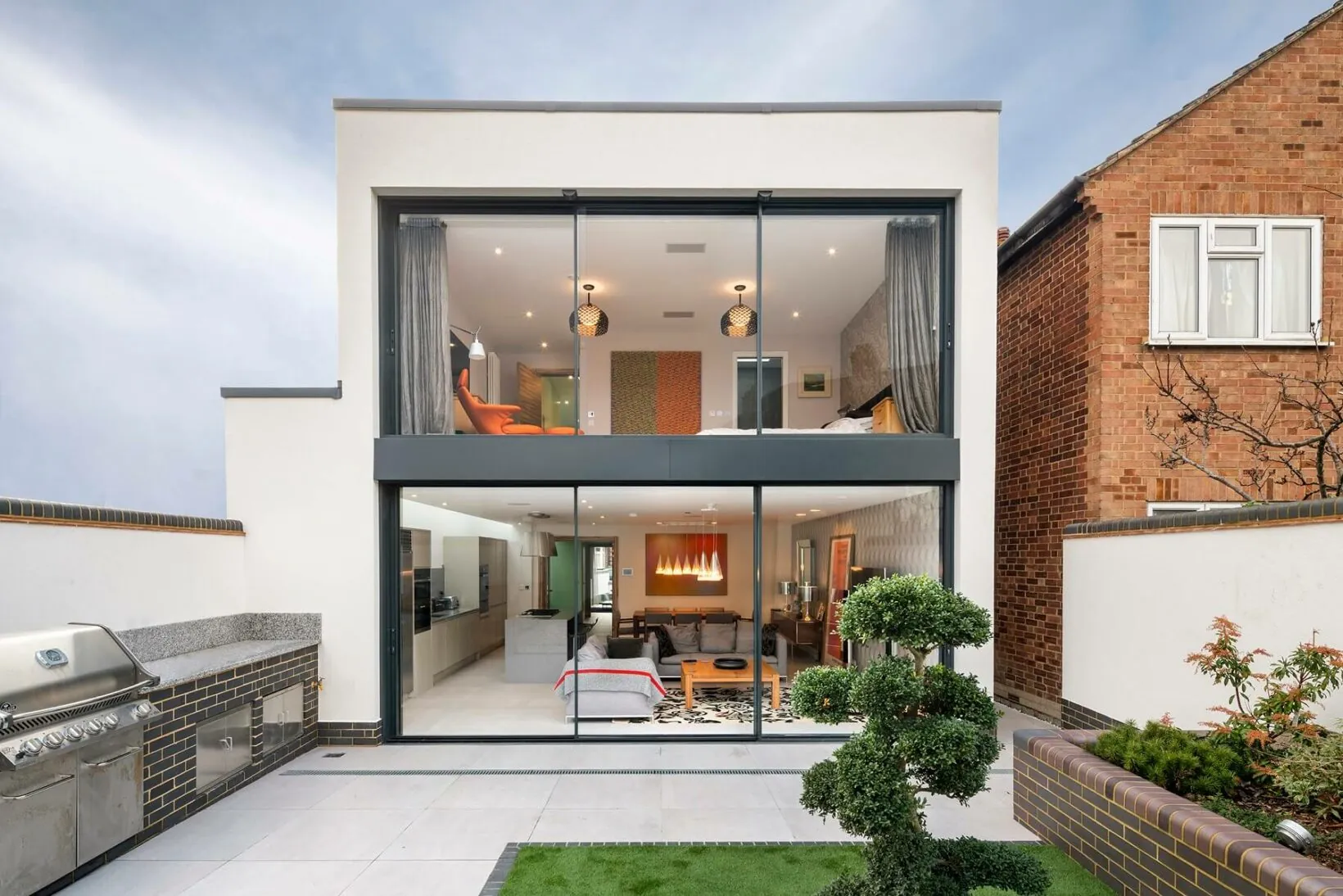
The position of your glass living room doors shapes how sunlight moves through the space as the day progresses. South-facing doors capture warm rays from dawn until dusk, while east-facing doors welcome bright morning sunshine. Modern designs now include specially treated glass that helps manage heat and glare without compromising brightness.
Natural light streaming through internal glass doors can brighten adjacent rooms and hallways too. This ripple effect means a single set of doors can improve lighting throughout your ground floor. During darker months, well-placed glass doors help you make the most of limited daylight hours.
Managing Seasonal Light Changes
Different glass coatings suit different aspects of your home. Low-emissivity glass reflects heat back into your room during winter while reducing glare in summer. Solar control glass cuts down excessive heat on south-facing walls without darkening the space.
Making Your Space Work Better
A range of styles commonly available lets you match glass living room doors to your space and needs. Minimalist sliding glass doors suit smaller rooms where every centimetre counts, gliding smoothly along tracks without intruding into your living area. Larger spaces might benefit from wide bifolds that stack neatly to one side.
Glass doors create visual links between spaces without removing physical boundaries. They let you divide open-plan areas while keeping sight lines open, perfect for watching children play or maintaining a connection with your garden. When closed, they act as sound barriers while preserving views and light flow.
The Impact on Home Value
British estate agents often highlight glass living room doors as a key selling point. They appeal to buyers looking for modern, light-filled homes that connect with outdoor spaces. The type of door you choose affects both immediate enjoyment and future returns – quality materials and proper installation matter more than following passing trends.
Glass doors can set your property apart in the housing market. They photograph well for listings and create memorable first impressions during viewings. The right doors show potential buyers how they might use the space year-round, from summer entertaining to cosy winter afternoons.
Which Glass Living Room Doors Should You Choose?

Sliding Living Room Glass Doors
Sliding glass living room doors bring clean lines and unbroken views. These doors run on tracks built into your floor, ceiling, or both, with panels gliding past each other to open. The slimline frames of sliding interior doors keep the focus on the glass itself, while robust locks and smooth-running wheels ensure reliable daily use.
Larger glass living room doors often work best as sliding systems, since the door weight rests on the tracks rather than hinges.
Premium systems use double or triple tracks to stack multiple panels, creating wider openings than standard double doors could offer. Multi-track systems let you partially open doors for ventilation without compromising security.
When space limits your options, glass living room internal sliding doors shine. Unlike hinged designs that need swing room, sliding panels move parallel to your walls. This space-saving trait proves invaluable in smaller homes or rooms with awkward layouts. The latest systems feature soft-close mechanisms and thermal breaks to prevent cold spots.
Technical Features to Look For
Built-in features make modern sliding systems a pleasure to use:
- Dual or quad wheels for smoother operation
- Multi-point locking systems
- Double or triple glazing options
- Thermally broken frames
- Adjustable rollers for fine-tuning
Bifolds for Wide Openings
Modern bifold doors have changed how we think about external doors. As an alternative to French doors or sliding doors, bifolding glass living room doors fold into compact stacks, creating broad apertures that connect spaces. Each panel links to its neighbours via hinges, letting you accordion them aside when open.
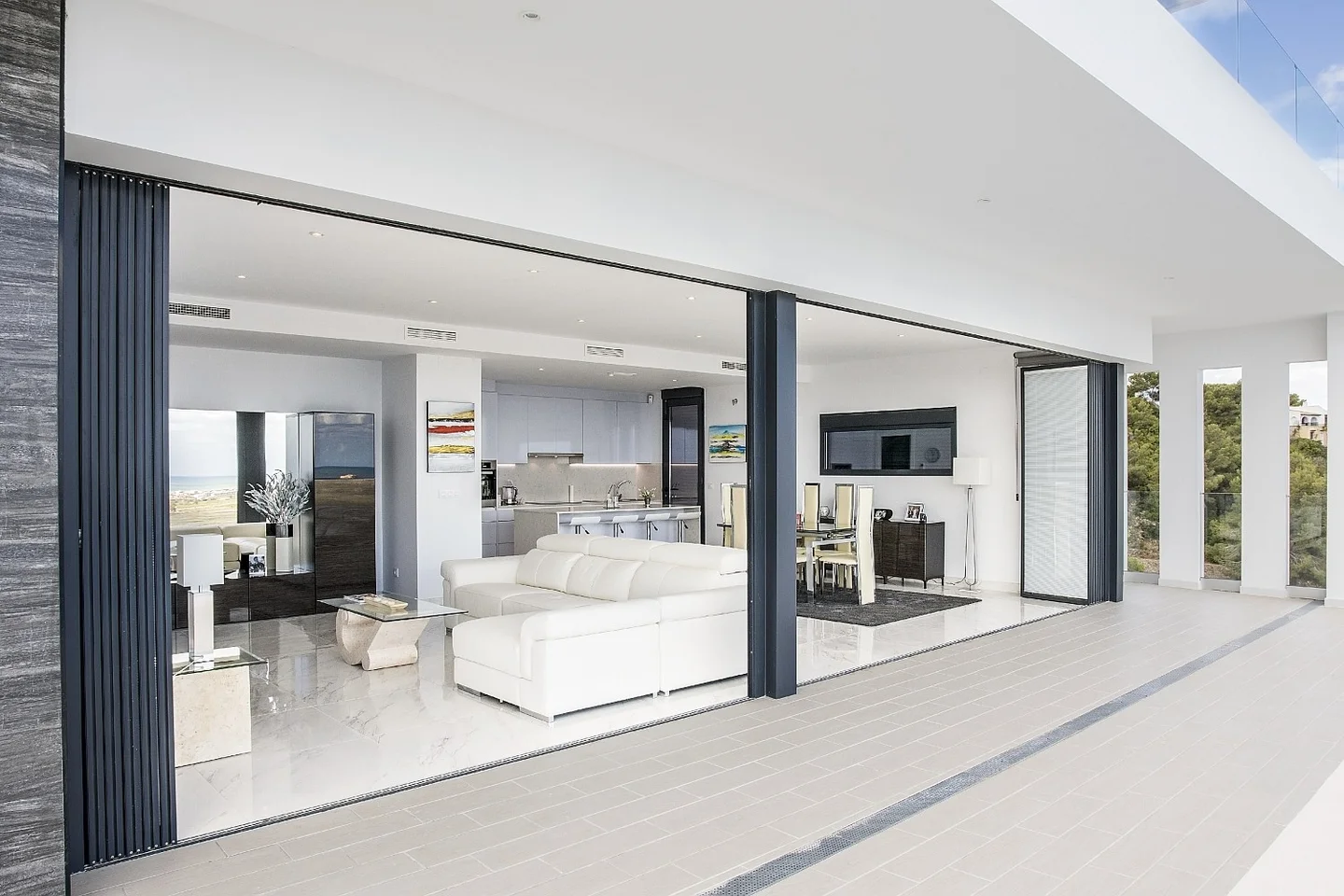
The frame thickness in living room doors with glass affects both looks and performance – slimmer frames increase glass area but might limit panel sizes. Top-hung systems need strong lintels but offer smoother operation, while bottom-rolling designs put less stress on your building’s structure. The number of panels changes how your doors work day-to-day – three-panel arrangements offer good access with minimal fuss, while five or more panels suit larger openings but need more wall space when stacked.

Frameless Glass Doors
Frameless glass living room doors push minimalism to its limit, using toughened glass thick enough to stand alone, with only minimal fixings visible. The price reflects their specialist nature, but they reward you with unrestricted views and pure architectural lines.
Living room glass doors in frameless designs need expert installation and careful use. Even small settling in your building can affect how well they work. Their impressive appearance comes from precision engineering – robust clamps and hinges hold the glass securely while staying nearly invisible.
French Doors
Traditional French-style doors remain a practical choice. Living room doors with glass in the French style suit period homes while fitting contemporary spaces too. Recent innovations include better seals, multipoint locks, and advanced glazing options that keep heat in and noise out.
The robust frame design handles frequent use well, making French glass living room doors ideal for busy family homes. Their balanced appearance works equally well for internal room dividers and garden access. Multi-point locking systems and laminated glass panels improve security without compromising the classic design.
Technical Performance
The materials behind your doors shape how well they work. Low-iron glass removes the slight green tint found in standard glass, while acoustic lamination cuts noise transfer without adding visible layers. Solar-control coatings manage heat gain more effectively than old-style tinted glass. Different frame materials bring their own benefits – powder-coated aluminium usually costs more than uPVC but needs less maintenance.
Strong, level floors support sliding doors best, while French and bifold systems rely more on their hinges and frame strength. Your existing opening might need adjusting to suit your chosen system. Price varies between types – basic sliding panels cost less than high-end bifolds or frameless options. Factor in professional installation, which often matches or exceeds the door price.
How to Design Around Glass Living Room Doors
Your living room layout needs careful planning to make the most of doors with glass. The way you arrange furniture, manage light, and control privacy shapes how well these doors work in your home.
Making Glass Work with Your Style
Glass living room doors work in both period and modern homes when you match materials and finishes thoughtfully. Dark aluminium frames bring a modern touch to contemporary spaces, while painted timber suits traditional rooms. The frame material affects more than looks – aluminium folding doors tend to offer slimmer sightlines than timber for example, though both can achieve high thermal performance.
Paint colours near your doors affect how light moves through the space. Lighter walls reflect sunlight deeper into your room, while darker shades absorb it. The glass itself changes how colours look too – standard float glass has a slight green tinge that affects nearby paint colours, though low-iron options avoid this issue.
Toughened safety glass opens up new design possibilities for your living room. Unlike standard glass that breaks into sharp shards, this specially treated material crumbles into small, rounded pieces if damaged. Glass living room doors made with tempered glass let you create striking designs without compromising on safety.
Furniture Placement Tips
The position of your sofa and furniture shapes how you experience glass exterior doors – placing seating to face the glass makes outdoor views the focal point, while angling furniture at 45 degrees creates a more balanced arrangement that works for both viewing and conversation.
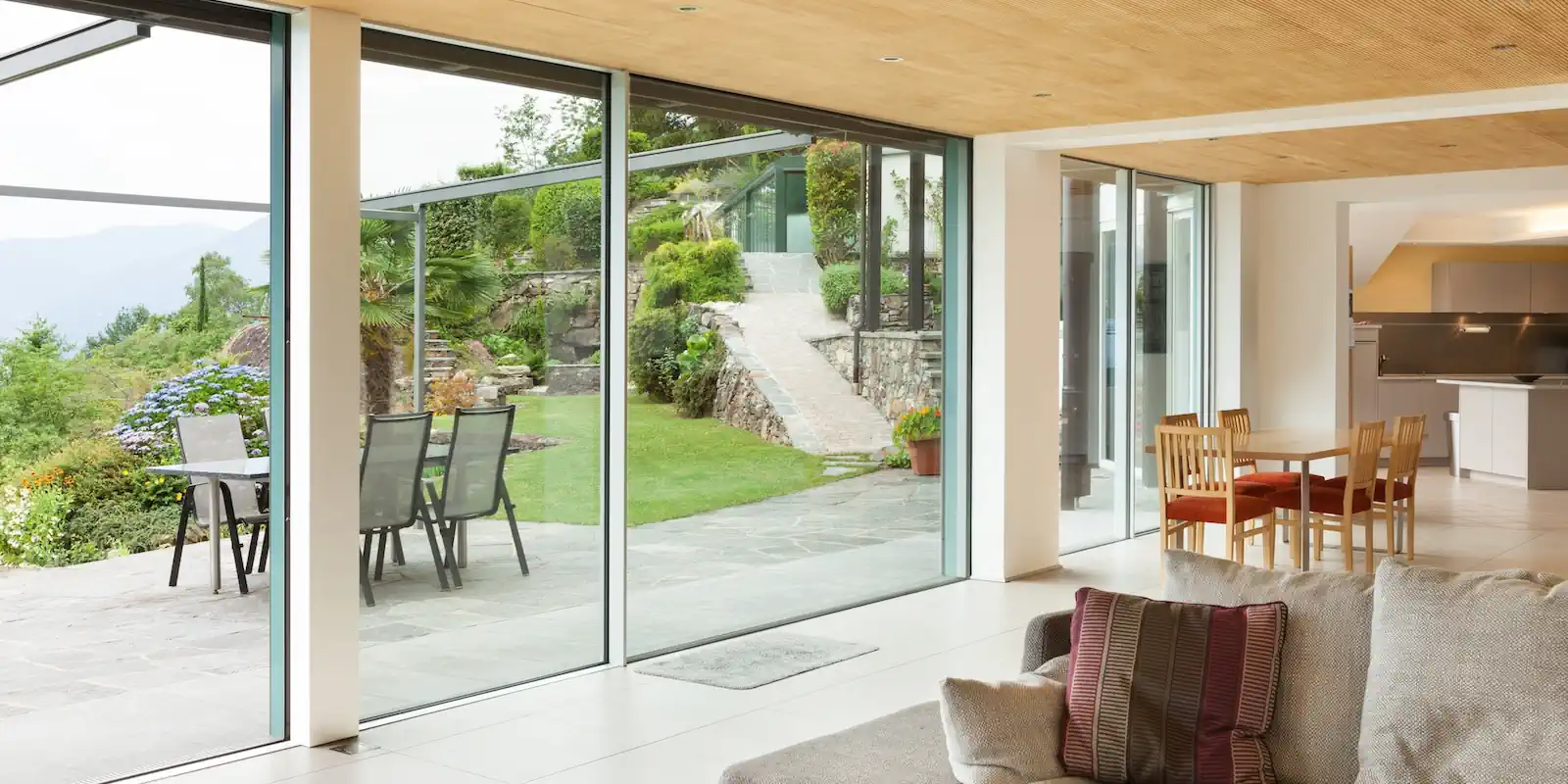
Heavy curtains or bulky furniture right next to glass living room doors can block light and make the space feel cramped. Light, flowing fabrics and low-profile pieces keep sight lines clear while still providing the privacy you need. Wall-mounted lights near the doors reduce glare on screens and create pleasant evening ambience.
Zoning Your Living Room
Glass internal doors help define different areas without putting up solid walls. They let you separate your living room from dining or kitchen spaces while keeping the overall space bright and connected. Using different flooring materials on either side of the doors strengthens these subtle divisions.
Managing Privacy and Light
Frosted glass doors offer a good balance between light and privacy. The textured surface obscures details while still letting plenty of brightness through, perfect for glass living room doors that face busy areas. Different frosting patterns create varying levels of privacy – full frost blocks most views, while decorative patterns maintain partial visibility.
Sometimes you want more control over privacy than plain glass can provide. Built-in blinds between glass panes never need dusting and stay protected from damage.
The level of privacy you need might change throughout the day. Partial screens or strategically placed plants create natural barriers without blocking all light. Solar control glass keeps rooms comfortable and private during the day while staying perfectly clear at night.
Lighting Design Around Glass Doors
Glass living room doors change how artificial lighting works in your living area. Spotlights aimed at the glass create unwanted reflections after dark, turning the doors into mirrors. Instead, position lights at angles or use diffused lighting to keep views clear while maintaining a cosy atmosphere.
Outdoor lighting needs equal attention – well-placed garden lights extend your view beyond the glass after sunset, making your room feel larger. Motion-sensor security lights serve a practical purpose without spoiling the night-time atmosphere when they’re not needed.
Working with Room Proportions
Long, narrow living rooms benefit from glass living room doors placed on the shorter wall. This arrangement draws the eye across the room’s width rather than emphasising its length. In square rooms, wide door openings on longer walls create a balanced look.
Managing Heat and Glare
South-facing glass needs extra thought. Overhanging eaves or external awnings block high summer sun while letting in winter light. Inside, light-filtering blinds or UV window films protect furniture from fading without darkening your room completely.
Creating Visual Flow
Your choice of glass living room doors affects the overall look of adjacent spaces too. When selecting frames and handles, think about how they’ll match existing finishes in connecting rooms. Hardware finishes that match your light switches and sockets create a pulled-together look.
Floor levels between spaces need careful planning. Flush thresholds look best but require good drainage if your doors open to the outside. Indoor-to-indoor glass living room doors usually work best with identical flooring running through, which helps spaces feel connected even when the doors are closed.
Common Questions About Glass Living Room Doors
Most queries about doors for living spaces focus on practical matters like warmth, noise, and upkeep. Here’s what you need to know about these key aspects of glass doors.
Keeping Warm in Winter
Double glazed doors trap air between two panes of glass, cutting heat loss and keeping your room cosy. Modern glass living room doors often feature argon gas between the panes, which works better than air at stopping heat transfer. The frame material matters too – aluminium sliding patio doors now include thermal breaks to prevent cold spots.

Winters demand good insulation, and today’s glass technology delivers. The latest coating technologies reflect heat back into your room while letting sunlight through. Living room doors with glass no longer mean choosing between views and warmth.
Proper installation makes all the difference to thermal performance. Even the best glass sliding doors for living rooms will let in draughts if poorly fitted. Quality seals and correct adjustment keep cold air out and reduce energy bills.
Year-Round Maintenance
Living room glass doors need regular cleaning to look their best. A mixture of warm water and a small amount of washing-up liquid works well for routine cleaning. Avoid abrasive cleaners that might scratch the glass or damage protective coatings.
Track maintenance keeps doors running smoothly. Living room doors with glass panels can become harder to slide if dirt builds up in the runners. A quick vacuum and wipe-down every few weeks prevents most issues, while a yearly deep clean and adjustment helps avoid bigger problems.
The illusion of space that glass creates stays strong when your doors work properly. Glass living room doors with well-maintained hardware open and close easily, making daily use a pleasure rather than a chore. Regular checks of hinges, locks, and sliding mechanisms catch small issues before they grow.
Security Features That Work
Living room glass doors offer practical benefits beyond looks. Modern locking systems embed multiple points of security into the frame, while toughened and laminated glass resists both accidental damage and deliberate attack. Decorative glass patterns can add an extra layer of security by obscuring views into your home.
Quality hardware forms the backbone of door security. Sliding patio doors now generally come with anti-lift mechanisms and multi-point locks as standard. Even simple measures like security film on glass panels increase protection without compromising views.
Acoustic insulation helps create a peaceful living environment. Glass living room doors with laminated panels reduce noise transfer, perfect for homes near busy roads or in urban areas. Some systems cut noise by up to half compared to standard double glazing.
Long-Term Value
Good-quality doors pay back their cost through durability and performance: frame materials affect both initial price and long-term value – powder-coated aluminium needs minimal upkeep, while timber might need periodic repainting but offers easier repairs.
Small touches make a big difference to everyday use. Soft-close mechanisms prevent slamming, while easy-clean coatings on the glass cut down maintenance time. Living room doors with glass panels should work effortlessly for years with basic care.
Balancing cost against quality often proves worthwhile. Glass sliding doors for living rooms from respected manufacturers tend to operate smoothly for longer, with spare parts available if needed. The initial investment in quality components typically saves money over time through reduced repairs and better performance.
About SunSeeker Doors
With over 20 years of experience, SunSeeker Doors remains at the forefront of door design with our quality-tested patio doors and related products, including the bespoke UltraSlim aluminium slide and pivot door system, Frameless Glass Doors, and Slimline Sliding Glass Doors. All of our doors are suitable for both internal and external use.
To request a free quotation, please use our online form. You may also contact 01582 492730, or email info@sunseekerdoors.co.uk if you have any questions.



